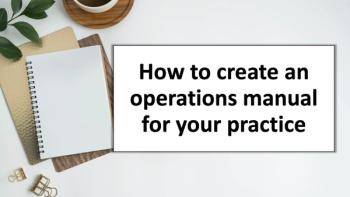
Pre-Planning the Office Visit
Ease your schedule with pre- and post-visit planning
It's a common and increasingly accurate perception that the outpatient physician office visit has become more about administration and less about care delivery.
Patients complain that administrative and coordination chores eat up too much of the time they spend with their physicians. Staff members are besieged by paperwork and processes that delay visit start times and upend patient flow. Meanwhile, physicians shoulder a greater number of care coordination tasks that erode productivity and impede their ability to practice medicine. The result?
Dissatisfied and disheartened patients, staff, and physicians.
We don't have the power to eliminate all of the bureaucracy, so how can we ease these strains? The answer is to stop doing any tasks during the patient visit that do not require the patient to be present. With thoughtful pre- and post-visit planning, you can shift many tasks out of a patient's appointment time.
More medical practices are anticipating the tasks necessary to support the patient's visit and doing them before or after the visit, promoting streamlined, coordinated care that respects everyone's time. Ultimately, it allows more patients to be seen each day.
Make it a value and a goal
Figuring out the best plan to execute the many tasks connected to a patient visit starts with a look at your practice's values. Let's assume that the physicians in your practice feel strongly that the physician-patient interaction must be uninterrupted, coordinated, high quality, sensitive to the patient's time, and designed to make maximum use of physician resources.
Streamlining on-site care is critical to maintaining the sanctity of the patient-physician interaction. Set a practice-wide goal that while a patient is within your practice, you and your staff will do only the activities that must be done while that patient is on-site. Your front-office staff will have verified the patient's insurance status, pulled the patient's charts, and performed other related tasks before the appointment.
A well-planned approach to pre-visit activity will give staff more time to collect co-pays, schedule necessary follow-up appointments, and perform other tasks that should be done while the patient is on-site. Segregating clinical duties before, during, and after the patient visit will allow each member of the patient care team to focus on the patient, not paperwork, during the patient visit.
Streamline on-site care
Take these steps for more streamlined patient visits:
- Prepare a flow chart of all patient interactions. It should list every event from the patient's first telephone call through the visit, and include all follow-up tasks.
- List all the staff positions clinical and administrative - that are part of the process.
- Define who does what. Hold staff accountable for accomplishing their tasks.
- Note when each task gets done. Anticipating patient needs and organizing your staff resources to meet them prior to the visit lets everyone focus on serving patients' clinical needs while they are in the office.
- Allocate the timing of task execution into the categories of:
- Pre-visit patient care management: tasks that can and should be done before the patient arrives.
- On-site visit management: tasks that must be done while the patient is on-site.
- Post-visit patient care managment: tasks that can and should be done after the patient's visit or in anticipation of the next visit.
Allocating is important
The first column of the chart below contains a sample task allocation for an internal medicine practice that struggled with this issue. The second column shows the staffing assignments for this practice of 5.5 full-time equivalent physicians.
After carefully considering what could be done when, the practice began reviewing all charts before visits to ensure that all test results were present. This simple step streamlined and improved the practice's care in the exam room. The physicians are much less likely to interrupt patient visits to track down missing test results.
This internal medical practice also learned that having schedulers ask patients a few questions to help determine the reason(s) for the visit while they were scheduling the appointment allowed the clinical staff to better prepare exam rooms with necessary supplies and to assemble relevant patient education materials before the patient's arrival.
In specialty practices, the allocation of tasks can be more complex but the rewards can be greater. Patients whose needs are better anticipated are spared long waits. Physicians whose test-ordering and other care needs are planned ahead can do more quantitatively and qualitatively for the patient during the visit.
Gain buy-in
Task allocation can be tricky. It must be discussed with and agreed upon by all physicians and staff to gain their perspectives on task timing. A task allocation plan that works is one that takes into account the number of providers in the practice, whether they are full- or part-time, the number of available staff, and whether staff must cross-cover various duties. Failure to take these important variables into account may doom even the best-designed allocation plan.
Larger practices have the opportunity to dedicate one or more specialized staff members to each task. In smaller practices, employees might handle several functions. Regardless of your practice's size, it is essential that you allocate tasks to specific individuals and hold them accountable for timely execution.
Most practice staff are accustomed to pitching in and doing whatever is necessary to get the job done on a minute-by-minute basis. Streamlining the patient visit will require a higher level of discipline to ensure that pre-visit and post-visit tasks do not creep into patient visit time. But, ultimately, it will reduce competing demands and expectations.
Avoid pitfalls
Not surprisingly, physicians, staff, and patients are delighted when administrative and clinical follow-up chores can be completed away from the hubbub of the office and do not impede visit time. Any stumbling blocks that practices experience tend to be a result of poor planning rather than faulty execution. Here are five actions to ensure a smooth implementation:
Gain physician compliance. Physicians may perceive that their needs or their patients' needs will not be met swiftly, correctly, or comprehensively. The practice administrator must deliver an infrastructure and level of staff performance that meets those needs. Physicians are usually eager to channel their patients through a system that promises optimal coordinated patient care and delivers on the promise.
Identify operational constraints. Lack of capacity, rapid growth, high demand, facility inadequacies, and glitches in laboratory results-management, electronic medical records, or other support systems can severely constrain the performance of physicians and staff. These issues, which always seem to rear up at less-than-ideal times, prevent staff from performing the right tasks at the right time.
Operational constraints can cause "task-creep." For example, if no one has time to check patient account balances before the visit, staff may try to do so while patients are waiting at the check-out counter, which delays other tasks. More task-creep occurs as staff try to keep up and the checking for past-due amounts is delayed again.
Soon patients are walking out without anyone checking to see if they owe the practice money, which means you must send billing statements, often for two or more cycles to collect small amounts. Similar task shifts can occur with certain clinical tasks like processing test results or checking for prescription renewals.
Develop standardized processes and associated protocols and tools. Often, physicians and administrators perceive that staff are performing inconsistently. There may be some truth to it - there are as many ways of doing things in a practice as there are staff and physicians. Minimizing variation in performance of tasks is an essential step to ensure that staff consistently meet patients' and physicians' needs.
Prepare a standardized task list for each employee type. This list goes beyond the job description. It describes every task required of each employee position. The task list will create more clear and mutual understandings of duties by function. It also will help staff cover for each other during absences as well as help speed the training of new employees.
Provide staff orientation and competency testing. While standardized processes and assignments go a long way toward creating consistent patient-visit support, success depends upon staff performance.
Pre-planning the patient visit has substantial benefits. Take a look around your practice and consider how a thoughtful approach to doing tasks at the most appropriate times can result in streamlined patient care, higher provider productivity, and happier patients.
Jayne Oliva, MBA, is a principal with The Croes/Oliva Group, a Burlington, Mass.-based medical group management consulting firm. She can be reached at
This article originally appeared in the March 2004 issue of Physicians Practice.
Newsletter
Optimize your practice with the Physicians Practice newsletter, offering management pearls, leadership tips, and business strategies tailored for practice administrators and physicians of any specialty.








